生物专业英语1
- 格式:ppt
- 大小:421.50 KB
- 文档页数:36
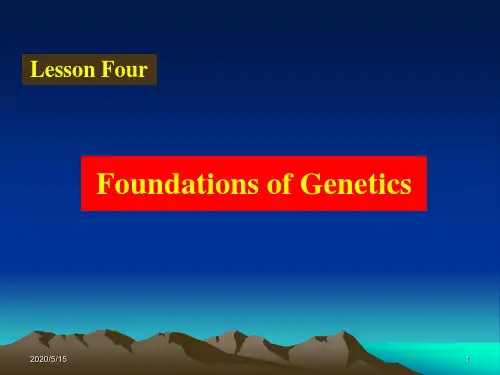
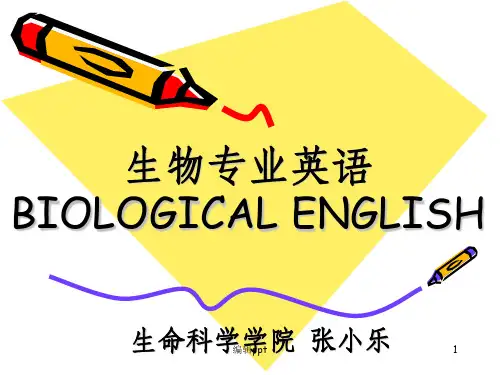
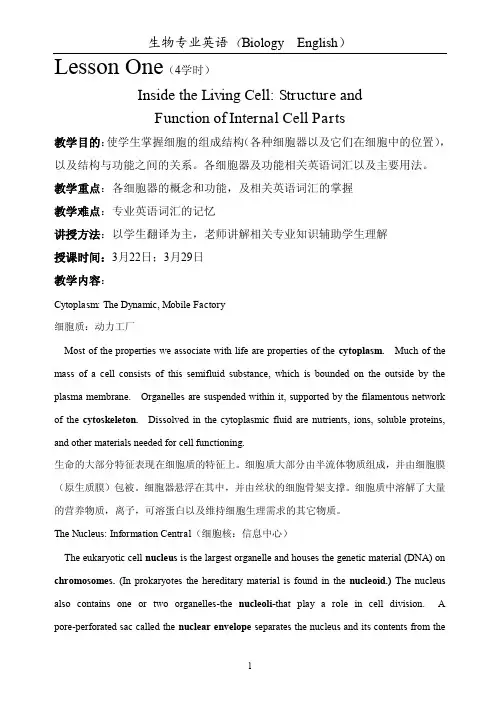
Lesson One(4学时)Inside the Living Cell: Structure andFunction of Internal Cell Parts教学目的:使学生掌握细胞的组成结构(各种细胞器以及它们在细胞中的位置),以及结构与功能之间的关系。
各细胞器及功能相关英语词汇以及主要用法。
教学重点:各细胞器的概念和功能,及相关英语词汇的掌握教学难点:专业英语词汇的记忆讲授方法:以学生翻译为主,老师讲解相关专业知识辅助学生理解授课时间:3月22日;3月29日教学内容:Cytoplasm: The Dynamic, Mobile Factory细胞质:动力工厂Most of the properties we associate with life are properties of the cytoplasm. Much of the mass of a cell consists of this semifluid substance, which is bounded on the outside by the plasma membrane. Organelles are suspended within it, supported by the filamentous network of the cytoskeleton. Dissolved in the cytoplasmic fluid are nutrients, ions, soluble proteins, and other materials needed for cell functioning.生命的大部分特征表现在细胞质的特征上。
细胞质大部分由半流体物质组成,并由细胞膜(原生质膜)包被。
细胞器悬浮在其中,并由丝状的细胞骨架支撑。
细胞质中溶解了大量的营养物质,离子,可溶蛋白以及维持细胞生理需求的其它物质。
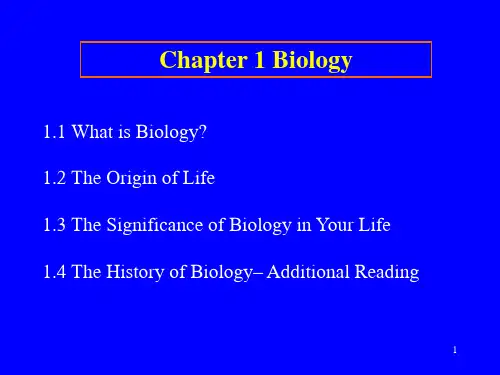
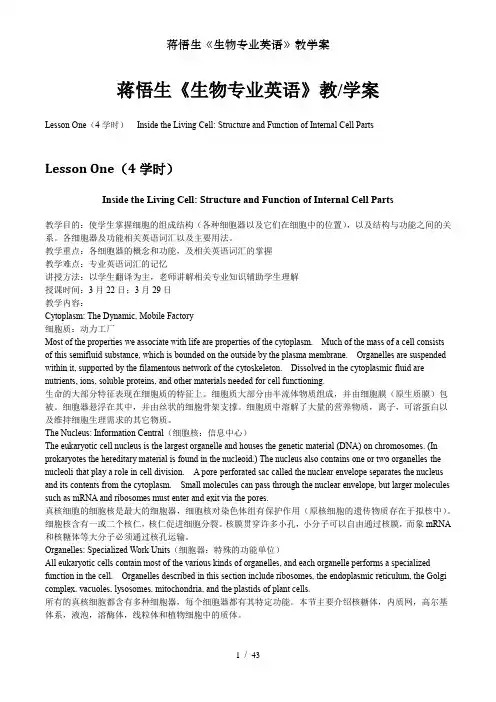
蒋悟生《生物专业英语》教/学案Lesson One(4学时)Inside the Living Cell: Structure and Function of Internal Cell PartsLesson One(4学时)Inside the Living Cell: Structure and Function of Internal Cell Parts教学目的:使学生掌握细胞的组成结构(各种细胞器以及它们在细胞中的位置),以及结构与功能之间的关系。
各细胞器及功能相关英语词汇以及主要用法。
教学重点:各细胞器的概念和功能,及相关英语词汇的掌握教学难点:专业英语词汇的记忆讲授方法:以学生翻译为主,老师讲解相关专业知识辅助学生理解授课时间:3月22日;3月29日教学内容:Cytoplasm: The Dynamic, Mobile Factory细胞质:动力工厂Most of the properties we associate with life are properties of the cytoplasm. Much of the mass of a cell consists of this semifluid substance, which is bounded on the outside by the plasma membrane. Organelles are suspended within it, supported by the filamentous network of the cytoskeleton. Dissolved in the cytoplasmic fluid are nutrients, ions, soluble proteins, and other materials needed for cell functioning.生命的大部分特征表现在细胞质的特征上。

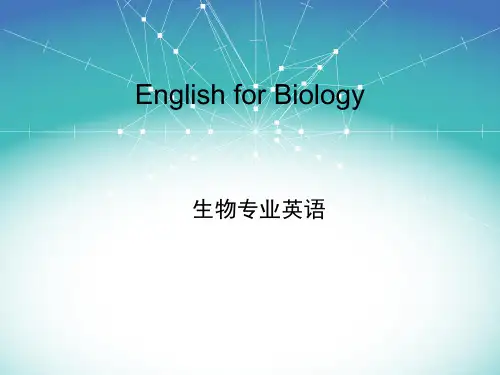
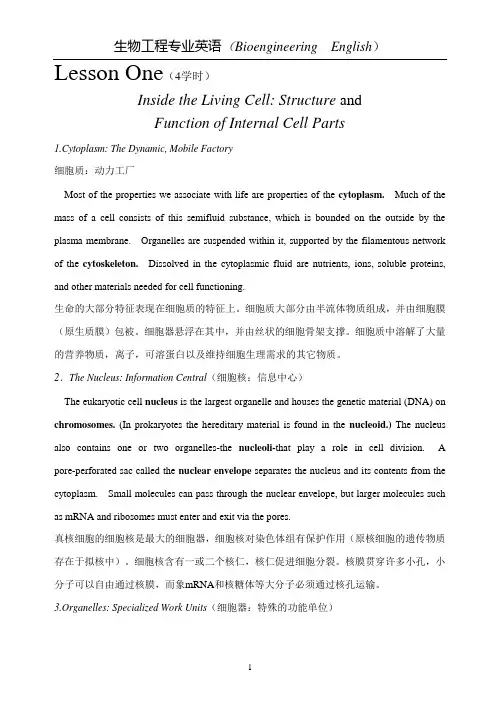
Lesson One(4学时)Inside the Living Cell: Structure andFunction of Internal Cell Parts1.Cytoplasm: The Dynamic, Mobile Factory细胞质:动力工厂Most of the properties we associate with life are properties of the cytoplasm. Much of the mass of a cell consists of this semifluid substance, which is bounded on the outside by the plasma membrane. Organelles are suspended within it, supported by the filamentous network of the cytoskeleton. Dissolved in the cytoplasmic fluid are nutrients, ions, soluble proteins, and other materials needed for cell functioning.生命的大部分特征表现在细胞质的特征上。
细胞质大部分由半流体物质组成,并由细胞膜(原生质膜)包被。
细胞器悬浮在其中,并由丝状的细胞骨架支撑。
细胞质中溶解了大量的营养物质,离子,可溶蛋白以及维持细胞生理需求的其它物质。
2.The Nucleus: Information Central(细胞核:信息中心)The eukaryotic cell nucleus is the largest organelle and houses the genetic material (DNA) on chromosomes. (In prokaryotes the hereditary material is found in the nucleoid.) The nucleus also contains one or two organelles-the nucleoli-that play a role in cell division. A pore-perforated sac called the nuclear envelope separates the nucleus and its contents from the cytoplasm. Small molecules can pass through the nuclear envelope, but larger molecules such as mRNA and ribosomes must enter and exit via the pores.真核细胞的细胞核是最大的细胞器,细胞核对染色体组有保护作用(原核细胞的遗传物质存在于拟核中)。
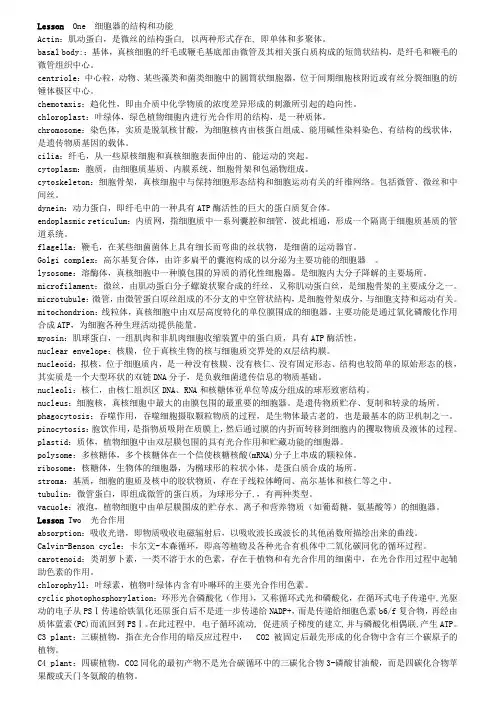
Lesson One 细胞器的结构和功能Actin:肌动蛋白,是微丝的结构蛋白, 以两种形式存在, 即单体和多聚体。
basal body::基体,真核细胞的纤毛或鞭毛基底部由微管及其相关蛋白质构成的短筒状结构,是纤毛和鞭毛的微管组织中心。
centriole:中心粒,动物、某些藻类和菌类细胞中的圆筒状细胞器,位于间期细胞核附近或有丝分裂细胞的纺锤体极区中心。
chemotaxis:趋化性,即由介质中化学物质的浓度差异形成的刺激所引起的趋向性。
chloroplast:叶绿体,绿色植物细胞内进行光合作用的结构,是一种质体。
chromosome:染色体,实质是脱氧核甘酸,为细胞核内由核蛋白组成、能用碱性染料染色、有结构的线状体,是遗传物质基因的载体。
cilia:纤毛,从一些原核细胞和真核细胞表面伸出的、能运动的突起。
cytoplasm:胞质,由细胞质基质、内膜系统、细胞骨架和包涵物组成。
cytoskeleton:细胞骨架,真核细胞中与保持细胞形态结构和细胞运动有关的纤维网络。
包括微管、微丝和中间丝。
dynein:动力蛋白,即纤毛中的一种具有ATP酶活性的巨大的蛋白质复合体。
endoplasmic reticulum:内质网,指细胞质中一系列囊腔和细管,彼此相通,形成一个隔离于细胞质基质的管道系统。
flagella:鞭毛,在某些细菌菌体上具有细长而弯曲的丝状物,是细菌的运动器官。
Golgi complex:高尔基复合体,由许多扁平的囊泡构成的以分泌为主要功能的细胞器。
lysosome:溶酶体,真核细胞中一种膜包围的异质的消化性细胞器。
是细胞内大分子降解的主要场所。
microfilament:微丝,由肌动蛋白分子螺旋状聚合成的纤丝,又称肌动蛋白丝,是细胞骨架的主要成分之一。
microtubule:微管,由微管蛋白原丝组成的不分支的中空管状结构,是细胞骨架成分,与细胞支持和运动有关。
mitochondrion:线粒体,真核细胞中由双层高度特化的单位膜围成的细胞器。
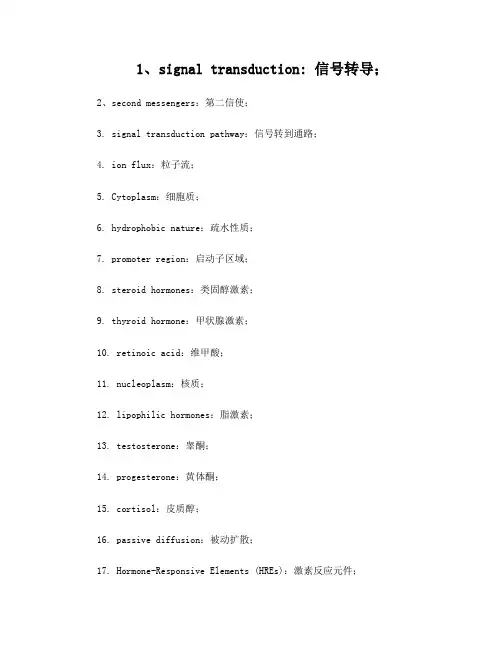
1、signal transduction: 信号转导;2、second messengers:第二信使;3. signal transduction pathway:信号转到通路;4. ion flux:粒子流;5. Cytoplasm:细胞质;6. hydrophobic nature:疏水性质;7. promoter region:启动子区域;8. steroid hormones:类固醇激素;9. thyroid hormone:甲状腺激素;10. retinoic acid:维甲酸;11. nucleoplasm:核质;12. lipophilic hormones:脂激素;13. testosterone:睾酮;14. progesterone:黄体酮;15. cortisol:皮质醇;16. passive diffusion:被动扩散;17. Hormone-Responsive Elements (HREs):激素反应元件;18. integral transmembrane proteins: 整合跨膜蛋白;19. tyrosine kinase:酪氨酸激酶;20. serine/threoine protein kinases:丝氨酸/苏氨酸蛋白激酶;21. Phosphatidylinositol:磷酸肌醇;22. Diacylglycerol (DAG):二酰基甘油;23. Inositol-triphosphate (IP3):三磷酸肌醇;24. arginine:精氨酸;25. citrulline:瓜氨酸;26. guanylate cyclase:鸟苷酸环化酶。
1. Cell communication : 细胞通讯;2. signal -transduction pathway:信号转导途径;3. growth factors:生长因子;4. paracrine signaling:旁分泌信号;5. neurotransmitter:神经递质;6. G-Protein-Linked Receptors: G-蛋白偶联受体;7. Tyrosine-Kinase Receptors:酪氨酸激酶受体;8. Ion-Channel Receptors:离子通道受体;9. Ligand-gated ion channels:配体门控离子通道;10. cytoskeleton:细胞骨架。
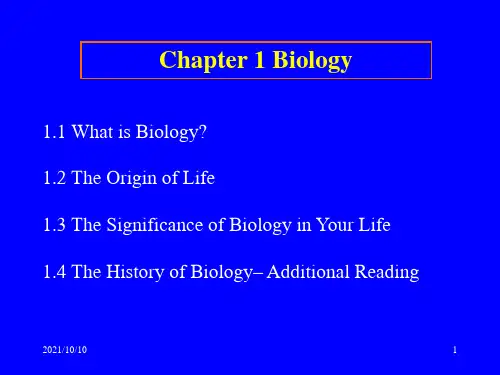
生物专业英语第一课Cytoplasm: The Dynamic, Mobile Factory细胞质:动力工厂Most of the properties we associate with life are properties of the cytoplasm. Much of the mass of a cell consists of this semifluid substance, which is bounded on the outside by the plasma membrane. Organelles are suspended within it, supported by the filamentous network of the cytoskeleton. Dissolved in the cytoplasmic fluid are nutrients, ions, soluble proteins, and other materials needed for cell functioning.生命的大部分特征表现在细胞质的特征上。
细胞质大部分由半流体物质组成,并由细胞膜(原生质膜)包被。
细胞器悬浮在其中,并由丝状的细胞骨架支撑。
细胞质中溶解了大量的营养物质,离子,可溶蛋白以及维持细胞生理需求的其它物质。
The Nucleus: Information Central(细胞核:信息中心)The eukaryotic cell nucleus is the largest organelle and houses the genetic material (DNA) on chromosomes. (In prokaryotes the hereditary material is found in the nucleoid.) The nucleus also contains one or two organelles-the nucleoli-that play a role in cell division. A pore-perforated sac called the nuclear envelope separates the nucleus and its contents from the cytoplasm. Small molecules can pass through the nuclear envelope, but larger molecules such as mRNA and ribosomes must enter and exit via the pores.真核细胞的细胞核是最大的细胞器,细胞核对染色体组有保护作用(原核细胞的遗传物质存在于拟核中)。
Lesson OneInside the Living Cell: Structure andFunction of Internal Cell Parts细胞的内部结构及其功能Cytoplasm: The Dynamic, Mobile Factory(细胞质:动力工厂)Most of the properties we associate with life are properties of the cytoplasm. Much of the mass of a cell consists of this semi-fluid substance, which is bounded on the outside by the plasma membrane. Organelles are suspended within it, supported by the filamentous network of the cytoskeleton. Dissolved in the cytoplasmic fluid are nutrients, ions, soluble proteins, and other materials needed for cell functioning.生命的大部分特征表现在细胞质的特征上。
细胞质大部分由半流体物质组成,并由细胞膜(原生质膜)包被。
细胞器悬浮在其中,并由丝状的细胞骨架支撑。
细胞质中溶解了大量的营养物质,离子,可溶蛋白以及维持细胞生理需求的其它物质。
The Nucleus: Information Central(细胞核:信息中心)The eu-karyotic cell nucleus is the largest organelle and houses the genetic material (DNA) on chromosomes. (In pro-karyotes the hereditary material is found in the nucleoid.) The nucleus also contains one or two organelles-the nucleoli-that play a role in cell division. A pore-perforated sac called the nuclear envelope separates the nucleus and its contents from the cytoplasm. Small molecules can pass through the nuclear envelope, but larger molecules such as mRNA and ribosomes must enter and exit via the pores.真核细胞的细胞核是最大的细胞器,在细胞核内的染色体上储存着遗传物质DNA(原核细胞的遗传物质存在于拟核中)。
Lesson One(4学时)生命的大部分特征表现在细胞质的特征上。
细胞质大部分由半流体物质组成,并由细胞膜(原生质膜)包被。
细胞器悬浮在其中,并由丝状的细胞骨架支撑。
细胞质中溶解了大量的营养物质,离子,可溶蛋白以及维持细胞生理需求的其它物质。
真核细胞的细胞核是最大的细胞器,细胞核对染色体组有保护作用(原核细胞的遗传物质存在于拟核中)。
细胞核含有一或二个核仁,核仁促进细胞分裂。
核膜贯穿许多小孔,小分子可以自由通过核膜,而象mRNA和核糖体等大分子必须通过核孔运输。
所有的真核细胞都含有多种细胞器,每个细胞器都有其特定功能。
本节主要介绍核糖体,内质网,高尔基体系,液泡,溶酶体,线粒体和植物细胞中的质体。
核糖体的数量变化从几百到几千,核糖体是氨基酸组装成蛋白质的重要场所。
完整的核糖体由大亚基和小亚基组成。
核糖体沿着mRNA移动并阅读遗传密码,翻译成蛋白质。
一条mRNA上可能有多个核糖体,称多聚核糖体。
大多数细胞蛋白是由细胞质中核糖体生产。
输出蛋白和膜蛋白通常与内质网有关。
内质网,带有花边的生物囊,有管状,泡状之分,以及光滑和粗糙面区别。
两种都与蛋白质的合成和运输有关。
粗糙内质网上分布许多核糖体,也可能提供细胞分裂后所需的细胞膜。
光滑内质网上无核糖体,主要作用是脂肪和类固醇的合成以及细胞内有毒物质的氧化。
两种内质网合成的产物在其中进行分流或运输到细胞外。
运输小泡能够将可运输分子从内质网运输到高尔基复合体上。
在高尔基复合体中修饰,包装后输出细胞或传递到细胞质中的其他场所。
细胞中的液泡好象是中空的,但实际上充满了液体和可溶分子。
最典型的液泡存在于植物细胞中,储备水,糖以及其它分子。
动物中的液泡起吞噬和胞饮作用。
溶酶体是液泡亚单位,含有消化酶,降解大部分生物大分子。
消化食物微粒和降解损伤的细胞残片。
线粒体是细胞中化学产能的场所。
另外,植物细胞中的质体在光合作用中利用光能产生碳水化合物,线粒体内嵴上提供了很大的表面积并分布着产ATP酶。